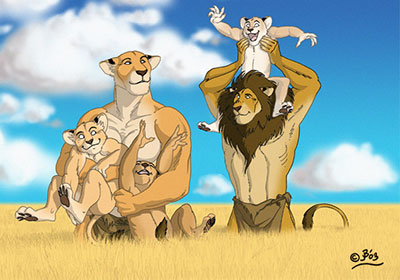Terra Advena - Gnoll Family Units, part 1

Today, I'm going to make a quick post discussing gnoll families - their structure and members, births, and how they differ between gnolls living in the Imperium and those living in the Territories. While you're reading it, keep in mind that adorable picture to the left. Aren't they cute? I think they're cute.
This is part 1 of a multi-part piece - for now, we're just covering the basics of early development and raising. Sometime soon, I'll come back to this and describe the typical gnoll family unit.
Gnoll Pregnancies and Development
In Terra Advena, gnolls, like the real-world animals they resemble, most commonly give birth in litters of 2-3 children. Unlike real-world animals, the mortality rate amongst the pups isn't particularly high - gnolls care and tend for their young. Also unlike most real-world animals, their gestation period isn't exactly short - gnoll pregnancies last anywhere between twice and three times as long as human pregnancies, depending on their subspecies. Ursine-type gnolls have the longest pregnancies, while felinedes have the shortest pregnancies. In any case, it's rare for pregnancies to be less than ten or twelve years apart, and gnolls remain fertile well into their fifties or sixties.
Gnoll infants are born weak and vulnerable, but not nearly so much so as human or dwarven infants. Gnoll pups are born with a full coat of fur and are usually crawling around on all fours within two weeks of birth. They continue developing at roughly twice the rate of a human child, until about four years of age. At that point, gnoll development slows down significantly, and they generally don't reach their full growth until their late 20s.
Within the Imperium, pups are generally raised in community litters, called ha-tek, separate from their parents, until their fourth year. During that time, they are cared for by elderly matrons apart from the rest of society. During their final year with the ha-tek, older male hunters take over the raising of the pups for several hours each day, teaching them the basics of hunting, gathering, and fighting. The position as such a tutor is an honored one, and only awarded to gnolls who have proven themselves as skilled warriors and hunters over the long years of their lives. Most gnolls form a meaningful attachment to both their litter-mates and their first such tutor that lasts a lifetime - even before they have formed such a bond with their parents.
Distinct from the Imperium, pups within the Territories live and learn with their families, a practice that was one of the original reasons for migration to the Territories in the first place - within the Imperium, such a thing is reserved only for noble families and forbidden to commoners.